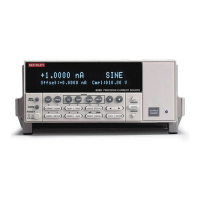Model 6220/6221 Reference Manual Delta, Pulse Delta, and Differential Conductance 5-33
Return to Section 5 topics
In cases where the high pulse will cause heating of the DUT, the measurement at
the second low pulse could be adversely affected by the heat caused by the high
pulse. In that case, the measurement at the second low pulse can be disabled.
This does not change the overall timing of the pulse output. Eliminating the sec-
ond low pulse measurement changes the basic calculation to the following:
Pulse Delta = (2Y – 2X) / 2
Where: Y is the measurement at the high pulse.
X is the measurement at the first low pulse.
Pulse Delta calculation example
3-point measurement technique – Assume you want to measure the voltage
across a low power 1Ω DUT. The Pulse Delta process will reduce DUT heating
and eliminate the effects of thermal EMFs.
Assume the Model 6221 is configured to output +10mA and 0mA pulses. Due to a
to a 10µV thermal EMF in the test leads, the following Model 2182A measurement
conversions (A/Ds) are made for the first Pulse Delta cycle.
A/D A = 0.01mV
A/D B = 10.01mV
A/D C = 0.01mV
The first Pulse Delta reading (using the 3-point measurement technique) is calcu-
lated as follows:
The above 3-point measurement technique effectively eliminated the 10µV ther-
mal EMF from the Pulse Delta reading.
2-point measurement technique – Assume for the above example that DUT
heating causes the A/D measurement at point C to be 1.01mV. Using the 3-point
measurement technique, Pulse Delta (by calculation) would instead be 9.5mV.
This results in 5% measurement error due to heating.
PulseDelta
2B A– C–
2
----------------------------
⎝⎠
⎛⎞
1–()
0
•=
2 10.01()0.01()– 0.01()–
2
--------------------------------------------------------------------=
20mV
2
----------------=
10mV=
Test Equipment Depot - 800.517.8431 - 99 Washington Street Melrose, MA 02176 - TestEquipmentDepot.com

